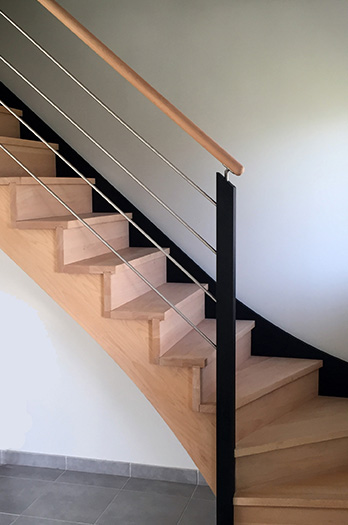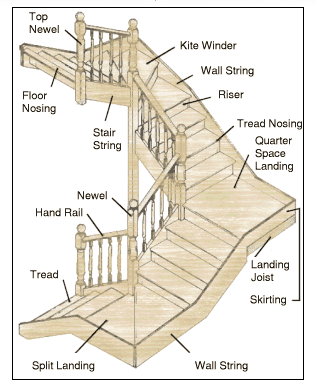The shapes
DIFFERENT SHAPES OF STAIRSThere are many different ways to design and build a staircase depending on the space available and the location of your staircase, straight staircases, curved or spiral... |
STRAIGHT STAIRCASEThe straight staircase is the most economical staircase. It has regular rectangular steps and does not change direction.It is ideal for rooms with high traffic as the input. It is ideal for small spaces because it offers an interesting storage space under its steps, unlike full stairs. The under stairs cupboard arrangement can be build if the configuration of the housing allows it. However, to be feasible, the right stairs request a large decline in space, so the stairs are too steep. |
|
1/4 TURN, 2/4 TURN, 1/2 TURN AND 3/4 TURN STAIRCASEThey have 1 or 2 angles. They combine space saving and aesthetic while allowing, just like the straight staircase, the first flight of stairs to be seen, facing a transition.Therefore, they perfectly fit in a corner between two walls and they can be with or without risers. With balanced steps, it will be more comfortable in the rise. ½ turn should have an intermediate bearing. |
|
SPIRAL STAIRCASEUnlike the straight staircase and winding staircase, the spiral staircase is much more easy to install as it does not require the support side of a wall. He moved into the smallest corner.All treads are organized around a central axis. 2 main advantages: • Brightness thanks to the absence of risers, • A real space saving. It fits perfectly in contemporary interiors. If it is made of metal, the spiral staircase gives the room a modern and trendy look. However, its small width is often incompatible with the transport of large items. The staircase is a particularly technical element with many criteria to consider. It is important to take into consideration the comfort and safety as well as the esthetics your stairs. Our Oeba advisors will help you understand all these aspects during a visit in store or at your home. |
Woods
THE TIMBER SPECIES FOR YOUR STAIRSDepending on the intended use of your staircase, you will have to choose a hard or soft wood.For an attic stairs, you can use a soft wood, which is often less resistant but more economical. For the staircase of an entrance hall, a hard wood that bears a repeated passage without damage would be better. |
Solid woods
Oak |
Beech |
Iroko |
Butted wood
Glued laminated oak |
Glued laminated oak |
Hevea |
|
Oak is a hard wood suitable for indoor stairs classics but also contemporary. Naturally strong and lasting. |
Beech is a hardwood, with a modern and warm appearance, naturally robust and resistant. |
The rubber tree is an exotic wood with a clear cream color, and a slightly laminated modern appearance. The wood is hard, strong, and very stable. Advantageous from an environmental point of view, it is a plantation wood that is cut after several years of latex production and then replanted. |
Raillings
CUSTOM-MADE STAIRS RAILINGSOeba Stairs railings can be made of different materials: wood railings, metal railings, stainless steel or glass. Wooden balusters, balustrades metal or stainless steel handrail in wood or stainless steel are essential elements that make up the railing of your custom-made Oeba staircase, all materials mixtures can be done to customize your Oeba staircase. |
Traditional model |
Contemporary model |
DIFFERENTS STAIRS RAILINGS FOR YOUR OEBA STAIRS
| Wood stairs railings | ||||
| Metal and wood stairs railings | ||||
| Glass stairs railings |
PAINT AND PROTECT YOUR OEBA STAIRCASE
|
Once installed, your wooden staircase Oeba must be treated quickly to prevent it to fail into dispair. If you want to keep the side natural wood or you prefer to customize it and give it a color... There are all kinds of finishes that will give a special touch to your staircase.
|
 |
STAIRCASE GLOSSARY
| • Stairs width: Distance between the two strings. • The riser: the board that forms the face of the strairs • The nosing: the edge of the tread projecting beyond the face of the riser and the face of a cut string. • The stairwell: The space provided for the stairs • The railing: security barrier placed on the sides of the stairs to prevent an accidental fall. The railing ensures that the stairs are safe for the people who are using it. The stairs railing is a set of handrails and balusters horizontal or vertical rails. • The tread: depth of the step. • The size of the stairs: Volume of the stairs at the ground - length x width. • The landing: the area of a floor near the top or bottom step of a stair. An intermediate landing is a small platform that is built as part of the stair between main floor levels and is typically used to allow stairs to change directions. • A quarter turn: A quarter turn stair is changing its direction either to the right or to the left but where the turn being affected either by introducing a quarter space landing or by providing winders. • Stolen: an uninterrupted series of treads without changes or rotations. A straight staircase has one series, while a quarter staircase has two series of treads. • Header or head breakaway: Distance between the upper part of the stairwell and the rebound of the stairwell. It must always be higher than 1.90m. If the break is too small, there is a risk of banging oneself's head into the upper wall. |
 |
